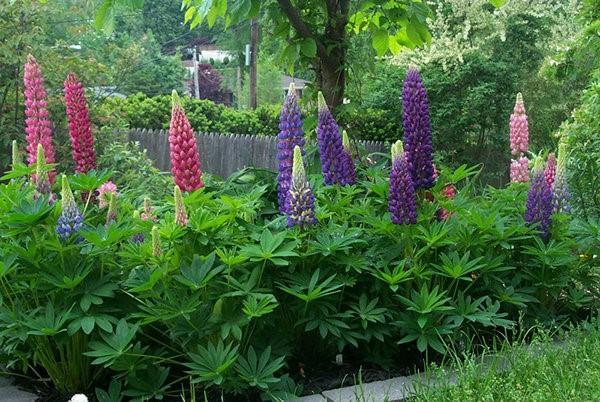Growing lupine in the garden: what to do so that it blooms magnificently every year
 The variety of flowers in the flower beds of amateurs is simply amazing, but the flower growers do not want to stop. Take, for example, growing lupine in the garden: meadow culture has long and reliably settled on our plots. Tall slender bushes with gorgeous lush rocking chairs of bright colors are in no way inferior in beauty. In addition, these plants are also quite unpretentious. Breeding by self-seeding, lupine will never emerge from your garden, and even the Russian winter does not care for him. If you are just starting to get acquainted with him, our article will help you understand the simple intricacies of growing lupine.
The variety of flowers in the flower beds of amateurs is simply amazing, but the flower growers do not want to stop. Take, for example, growing lupine in the garden: meadow culture has long and reliably settled on our plots. Tall slender bushes with gorgeous lush rocking chairs of bright colors are in no way inferior in beauty. In addition, these plants are also quite unpretentious. Breeding by self-seeding, lupine will never emerge from your garden, and even the Russian winter does not care for him. If you are just starting to get acquainted with him, our article will help you understand the simple intricacies of growing lupine.
The name of the plant, "lupus", translated from Latin means "wolf". For this, lupine is called wolf beans.
Choosing a place for lupine
For the bushes to grow well and bloom profusely, pick up a well-lit garden bed with lupine. It is desirable that it be protected from the wind, which can break the peduncles. In the shade, the plants are no longer so chic, and the flowering is more scarce and shallow.
Do not plant flowers in a flower bed where other legumes or cruciferous crops have previously grown. They have common diseases and pests with lupine. But after cereals, lupine grows well.
The plant loves soil that is loose and fertile. Dig up the beds before sowing, adding some sand, superphosphate and ash.
When and how to plant lupines
One of the advantages of the crop is that the seeds can be planted immediately in a permanent place. Agree, this is very convenient, because you do not need to bother with seedlings and transplants. The only thing is that the perennial varieties will bloom only next season.
You can sow seeds:
- at the end of September - in October;
- in spring, in April - May, when the warmth comes.
Make grooves or separate holes at once, shallow, and spread the seeds in them. Sprinkle with earth and mulch. When the seedlings grow up, thin out the crops that are too thick, replanting the bushes with a lump of earth.
When planting, consider the varietal characteristics of lupine. Some varieties grow up to 1 m wide, so leave enough space between the bushes.
Growing lupine in the garden: rules for caring for a blooming handsome man
Lupine care is similar to growing most garden plants, however, it has some small nuances:
- Water your beds regularly, especially during dry summers, but do not flood to a swampy condition. Lupine doesn't like this.
- Loosen the row spacing carefully after watering and rain.
- Pull out the weeds.
- As you grow, rake the ground with a hoe under the bushes, covering the root collar and preventing it from being exposed.
- From the second year of life, in the spring, start feeding with superphosphate and calcium chloride.
- Install supports for tall varieties.
In the middle of summer, when the lupine has faded, cut the inflorescences, and in August you will see the second wave of flowering.
In addition, it is advisable to cut them if you do not plan to collect seeds and turn the garden into a lupine plantation. This will help control self-seeding and there will be no question of how to remove overgrown thickets from the site.
Lupine reproduces not only by seeds. You can dig up an old bush in the spring and cut it apart. Delenki take root well, even if you damage the roots a little in the process.
Thus, growing lupines in the garden is no more troublesome than planting other flowers.It grows quickly, hibernates well even without shelter, and every summer it will delight you with abundant flowering.